The
Home Page Selection
If
you require further information on any
print featured here, please contact
us.
When
a print has been sold it will be marked
as Sold.
A
growing archive of selections
from previous Home pages is featured in
the
Home
Page Selection Archive |
|
See
also :
Click
on a thumbnail (left)
to link directly with the entry for that
print, or scroll down to view all the selected
prints from the current Home
Page.
Images
are not to relative scale (see stated dimensions) and also at only modest resolution.
If you wish to view extracts of an image at higher resolution, please Contact us.
|
|
|
|
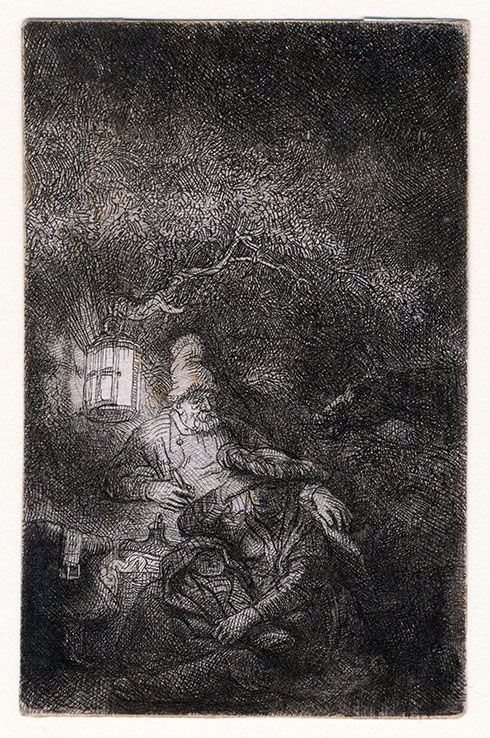
| |
REMBRANDT VAN RIJN
Leiden 1606 – 1669 Amsterdam
Rembrandt, from the early 1630’s, through the 1640’s
and into the 1650’s, produced some ten ‘black prints’;
the majority being religious themes.
In this Rest on the Fight into Egypt, the Holy Family,
and the foliage of the tree above them, are lit by the lantern
which they have hung on the branch of the tree.
The Rest on the Flight into Egypt: a night piece
Bartsch 57, New Hollstein 216 iii/ix
93 x 58 mm (sheet)
Original etching, c1644.
Trimmed to the plate.
Sold
Ex collection:
Artaria (Lugt 33)
Marquis de Lagoy (L.1710)
Pierre Sentuc (L.3608)
Dr K.O. (Ex Lugt)
In the early decades of the 17th century artists began to exploit
the potential chiaroscuro drama of night scenes, lit by
the natural light of the moon or the light from candles or lanterns.
These nocturnes called ‘black prints’ were popular with collectors.
The German artist Adam Elsheimer (settled in Rome) painted
his Flight into Egypt about 1609, probably his last painting before
his early death the following year.
It is considered the first naturalistic rendering of the sky at night,
with moon and stars, even the Milky Way. It also included a source
of light from a camp fire and was the first depiction
of the theme of The Flight into Egypt as a night scene, true to the
Biblical story.
Hendrik Goudt (who lodged in Elsheimer’s house in Rome) acquired
the painting and took it, and six other Elsheimer paintings on copper,
back to his native Utrecht when he left Rome in 1611.
Goudt’s engravings of these Elsheimer paintings had an enormous
impact in the Netherlands.
Goudt’s black prints, as Jan van de Velde’s in the following decade,
were engraved.
In the early 1630’s Lievens and Rembrandt, both working in Leyden,
made the first etched black prints.
Return to top ^ |
|
|
|
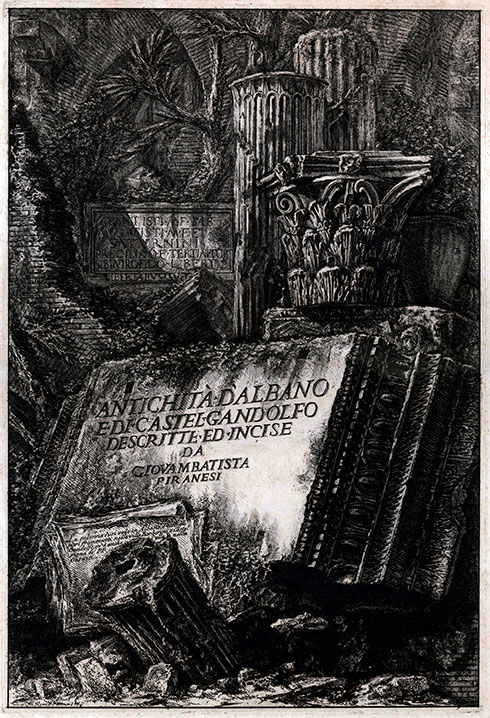
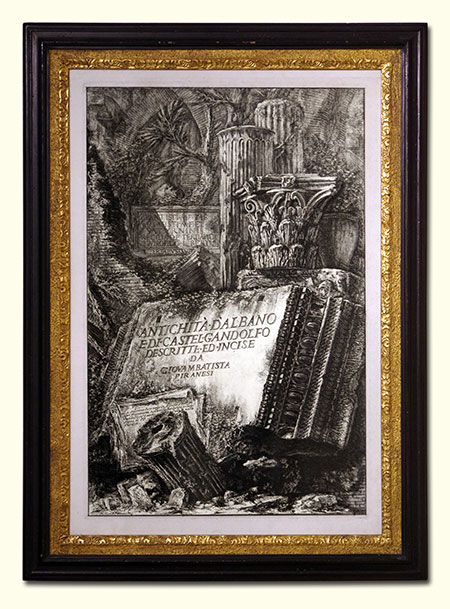
|
|
GIOVANNI BATTISTA PIRANESI
Mozzano di Mestre, Venice 1720 – 1778 Rome
Though formally trained as an architect (he signed numerous plates
as Piranesi, Venetian architect) Piranesi devoted most of his career
to etching, producing over 1000 plates, many of considerable size
and complexity. He also made archaeological investigations, and collected, creatively
restored and dealt in Roman antiquities.
He trained with his uncle, an architect, designer and engineer
responsible for the water management in the Venetian lagoon.
Piranesi learnt perspective drawing from the architect and theatrical
designer Carlo Zucchi; theatre design of the day was the province
of architects.
Piranesi would exploit the illusionistic characteristics of stage design
to great effect in the composition of his etchings.
Most of Piranesi’s working life was spent in Rome, where he settled
permanently in 1747. He first visited the city in 1740, as a draughtsman
in the train of Marco Foscarini, the Venetian ambassador to the newly
elected pope, Benedict XIV.
Sometime during the years of this initial visit he studied etching with
Giorgio Vasi, who declared Piranesi to be too much of a painter
to be an engraver.
Piranesi’s etchings were painterly. He made quick preparatory sketches
from which he improvised on the plate.
In later years, in addition to biting by immersion, he would brush acid
directly onto the plate to enrich tonality.
Rome captivated Piranesi. He found a powerful poetry in its contemporary
architectural splendour and the magnificence of the ancient ruins,
in evidence and being newly discovered.
His brother, a Carthusian monk, may already have fired his imagination
to classical antiquity even before Piranesi left Venice.
When Piranesi was at work on site at Albano, c1759, making his researches
into the Roman Emissarium, Clement XIII visited him and suggested
a wider survey of the antiquities of the area, which he would sponsor;
resulting in the Antichità d’Albano e di Castel Gandolfo, which Piranesi
published in 1764, with a double folio dedication page to the Pope.
Title to ANTICHITÀ D’ALBANO E DI CASTEL GANDOLFO
DESCRITTE ED INCISE DA GIOVAMBATISTA PIRANESI
Antiquities of Albano and Castel Gandolfo described and etched by
Giovam (sic) Battista Piranesi
Focillon 505; Wilton-Ely 638
501 x 326 mm
Original etching, 1764.
The plate signed and dated.
Edge-mounted.
One small paper defect in the lettering.
Sold
On the scroll towards the foot of the plate Piranesi specifies that the
shorter column (labelled A) is to be seen in Albano, while the other
fragments are found at the Villa Barbarini at Castel Gandolfo and
the urn (labeled B), is in the vineyard of the Jesuit Fathers.
(The illustrated frame is available).
Return to top ^ |
|
|
|
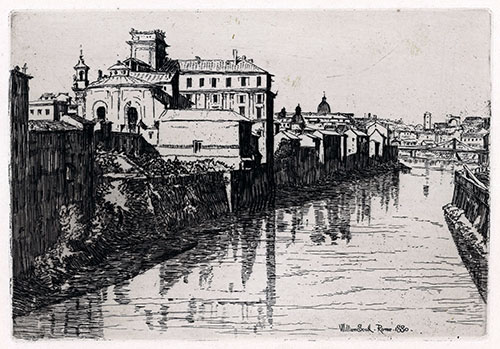 |
|
WILLIAM SCOTT R.E.
1848 – 1914
Scott was an architect, painter, watercolourist, etcher and lithographer.
He was an early member of the Royal Society of Painter-Etchers,
elected in 1881. He was active as an exhibitor from 1880 to 1897,
at the R.E. and elsewhere.
Scott mainly painted and etched Italian subjects.
He coincided with Whistler in Venice, when that latter was there,
commissioned by the Fine Art Society, and they became friends.
In London he attended Whistler’s Sunday Breakfasts.
Rome from the Ponte Sisto
149 x 215 mm
Original etching, 1880.
The plate signed and dated.
Published as Plate 24
in Part XXVI of The Etcher,
August 1881.
On cream wove paper.
£100
Return
to top ^ |
|
|
|
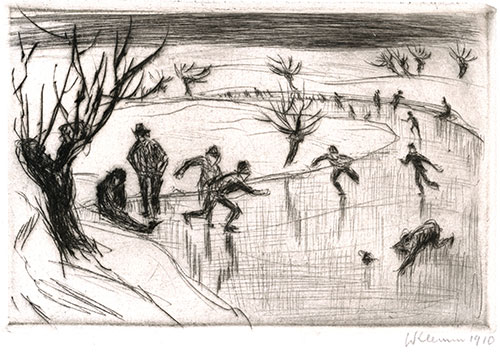 |
|
WALTHER KLEMM
Karlovy, Bohemia 1883 – 1957 Weimar
Klemm studied in Vienna and had taken up printmaking by 1903.
From 1904 he exhibited with the Vienna Secession, though he moved
to Prague, establishing a studio with Karl Thiemann.
In 1908 they both moved to the artists’ colony at Dachau.
Klemm settled in Weimar in 1913, where he was appointed
Professor at the Weimar Art School.
Skaters
98 x 145 mm
Original drypoint, 1910.
Signed in pencil and dated.
On cream wove trimmed in the margins.
Sold
Return
to top ^
|
|
|
|
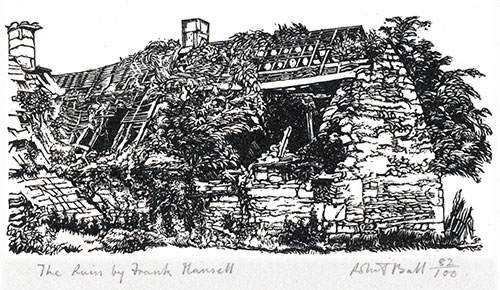 |
|
ROBERT BALL R.E.
Birmingham 1918 – 2008 Gloucestershire
Ball was trained at Birmingham School of Art and the Royal
College of Art.
He settled in Gloucestershire from 1953 when he was appointed
Principal at Stroud College of Art, where he remained as Senior
Lecturer in drawing and painting until 1981.
Ball was a friend of Laurie Lee and ‘The Cotswold Poet’, Frank Mansell
and illustrated the 1974 edition of Mansell’s Cotswold Ballads. Ball walked the terrain with Mansell to view the sites that had inspired
the poems.
The Ruins by Frank Mansell
55 x 115 mm
Original wood engraving, 1973
Signed in pencil, entitled and numbered
82/100.
On japan.
Sold
An R.E. Print Collectors’ Club Presentation print for 1973.
Though not included as an illustration in Frank Mansell’s
Cotswold Ballads, this image relates to Mansell’s ‘ballad’
The Ruin
Long years ago the busy masons wrought here
And schooled these walls from the obdurate stone
New-quarried, that the creaking carts had brought here
From quarries now unused and overgrown.
And day on day these tranquil hills resounded
With mason-music as the masters plied
Their sculpting hammers, and a farm was founded,
New-fashioned outcrop of the countryside.
So was it once, but now the walls are falling,
Wild rabbits graze the green-carpeted floor,
The beams are dust and the dark ivy crawling
Embraces all and mocks the mason’s hour.
Return
to top ^
|
|
|
|
|
|
|
|